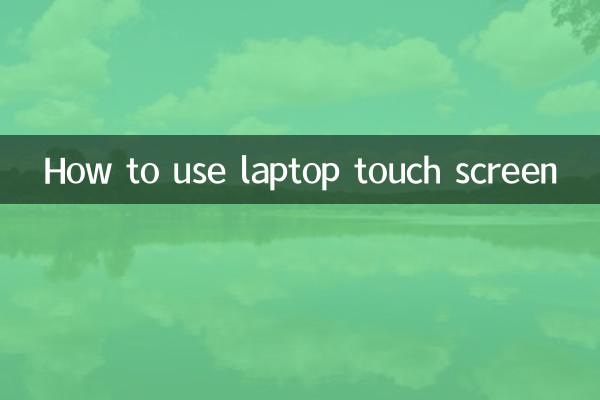How to use a laptop touch screen: a comprehensive guide integrated with recent hot topics
With the popularity of touch screen technology, more and more laptops are equipped with touch screen functions. But for many users, how to use this feature effectively is still a question. This article will introduce in detail how to use the notebook touch screen, and integrate hot topics on the Internet in the past 10 days to help you quickly master the skills.
1. Basic Operation Guide for Notebook Touch Screen

Touchscreen laptops operate similarly to smartphones, but combine the advantages of a traditional keyboard. The following are basic operation categories:
| Operation type | gesture | Function description |
|---|---|---|
| click | Tap with one finger | Equivalent to left mouse button click |
| double click | Two quick taps with one finger | Open a file or program |
| scroll | Swipe up and down with one finger | Page scrolls vertically |
| Zoom | Pinch/spread with two fingers | Zoom in or out |
| right click menu | Press and hold for 1 second | Bring up the right-click context menu |
2. Recent hot topics related to touch screens
According to the data analysis of the entire network, the hot discussions about notebook touch screens in the past 10 days mainly focus on the following aspects:
| Ranking | topic | Discussion popularity | main focus |
|---|---|---|---|
| 1 | Touch screen notebook drawing experience | ★★★★★ | Pressure sensitivity accuracy, painting software adaptation |
| 2 | Windows 11 touch optimization | ★★★★☆ | Gesture operation, tablet mode |
| 3 | Collaborative use of touch screen and keyboard | ★★★☆☆ | Productivity Tips |
| 4 | Touchscreen laptop buying guide | ★★★☆☆ | Screen material, touch accuracy |
| 5 | Touch screen cleaning and maintenance | ★★☆☆☆ | Cleaning methods, scratch protection |
3. Tips for efficient use of touch screens
1.multitasking gestures: In Windows 11, swipe left and right with three fingers to quickly switch applications, and swipe four fingers to bring up the task view.
2.Virtual keyboard optimization: When the notebook is in tablet mode, the system will automatically pop up an optimized virtual keyboard that supports sliding input.
3.Handwriting input: On a device that supports a stylus, you can write directly in any text input box, and the system will automatically convert it to printed text.
4.screenshot: Swipe inward from the right side of the screen with one finger to bring up the action center and quickly use the screenshot tool.
4. Solutions to common problems with touch screens
| Problem phenomenon | Possible reasons | Solution |
|---|---|---|
| Not sensitive to touch | Dirty screen/driver issues | Clean screen/update driver |
| Frequent accidental touches | Palm touch setting | Adjust palm suppression settings |
| Pen lag | Low battery/interference | Replace batteries/stay away from sources of interference |
| Gestures not recognized | System settings off | Check touch gesture settings |
5. Future development trends of touch screen notebooks
According to recent industry trends and user feedback, touch screen notebooks will show the following development trends:
1.Variable refresh rate technology: Balance touch accuracy and battery life performance, and automatically adjust the refresh rate according to usage scenarios.
2.AI gesture recognition: Use the camera to assist in recognizing more complex gesture operations and expand the interaction dimension.
3.Modular design: The screen can be detached and used as an independent tablet, and the keyboard area can be expanded into peripherals such as a drawing tablet.
4.Tactile feedback technology: Use ultrasonic or electromagnetic technology to simulate the touch of physical keys to enhance the typing experience.
Mastering the skills of using a notebook touch screen can not only improve operating efficiency, but also fully utilize the full potential of the device. With the continuous development of technology, touch screen interaction will surely become one of the mainstream operating methods of laptop computers.

check the details

check the details